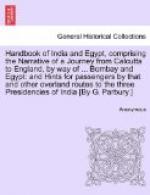Wherever a “tazia” or tomb is a-building, there gather all the Mohurrum performers, the Nal Sahebs or Lord Horse-shoes, the tigers and the mummers of Protean disguise. The spot becomes an “Akhada” or tryst at which the tomb-builders entertain all comers with draughts of sherbet or sugared water, but not with betel which has no place in seasons of mourning. Here for example comes a band of Marathas and Kamathis with bells upon their ankles, who form a ring in front of the “tazia”, while their leader chants in a loud voice:—
“Alif se Allah; Be se Bismillah;
Jum se meri
Jan. Tajun Imam Husein Ki nyaz dharun.”
“Alif for Allah; B for Bismillah;
J for my life.
An offering is this to Husein.”
The chorus take up the refrain at intervals accompanying it with the tinkle of the ankle-bells; and then as distant drumming heralds the approach of a fresh party, they repeat the Mohurrum farewell “Ishki Husein” (Love of Husein) and pass away with the answer of the tryst-folk: “Yadi Husein” (Memory of Husein) still ringing in their ears. The new party is composed of Bombay Musulman youths, the tallest of whom carries an umbrella made out of pink, green and white paper, under which the rest crowd and sing the following couplet relating to the wife and daughter of Husein:—
“Bano ne Sakinah se kaha. Tum
ko khabar hai
Baba gae mare!”
“Bano said unto Sakinah. Have
you heard that
your father is dead?”
This party in turn yields place to a band of pipers and drummers, accompanying men who whirl torches round their head so skilfully that the eye sees nought but a moving circle of flame; and they are succeeded by Musulman men and boys, disguised as Konkani fishermen and fishwives, who chant elegies to Husein and keep the rhythm by clapping their hands or by swinging to and fro small earthen pots pierced to serve as a lamp. The last troupe, dressed in long yellow shirts and loose yellow turbans, represent Swami Narayan priests and pass in silence before the glittering simulacrum of the Martyr’s tomb.




